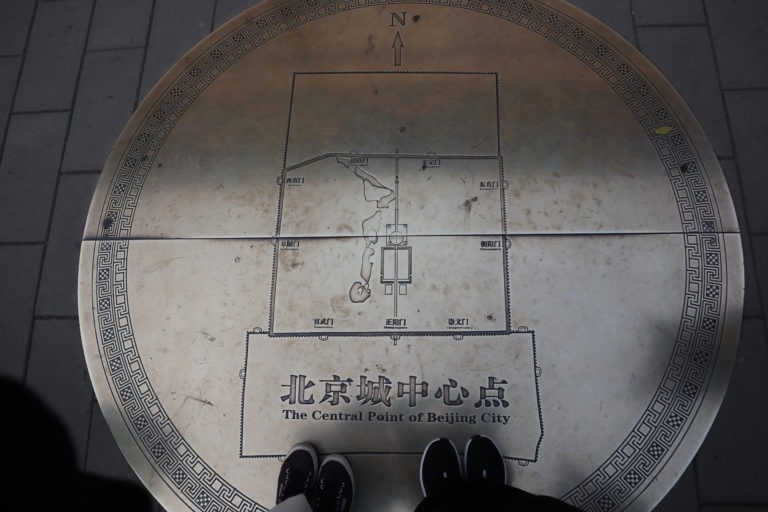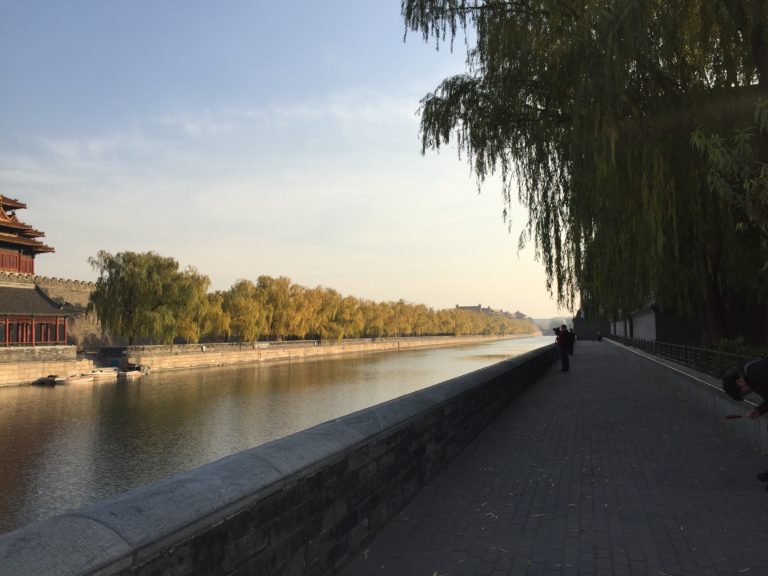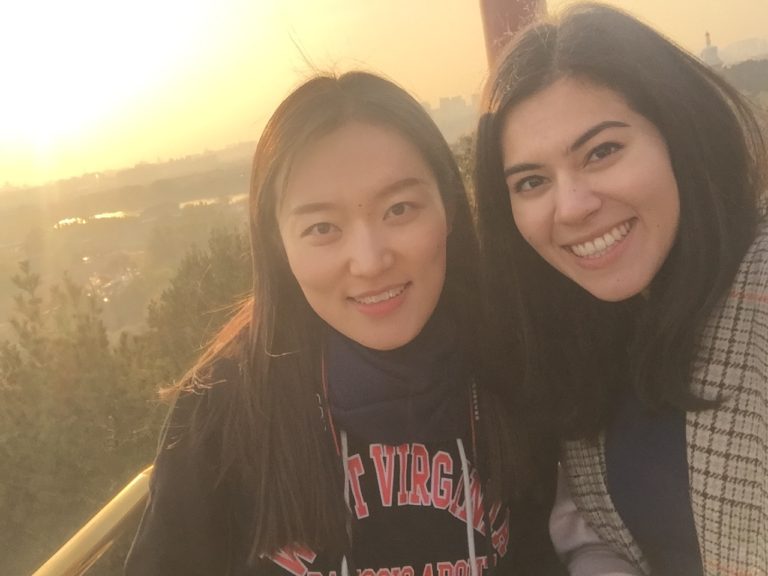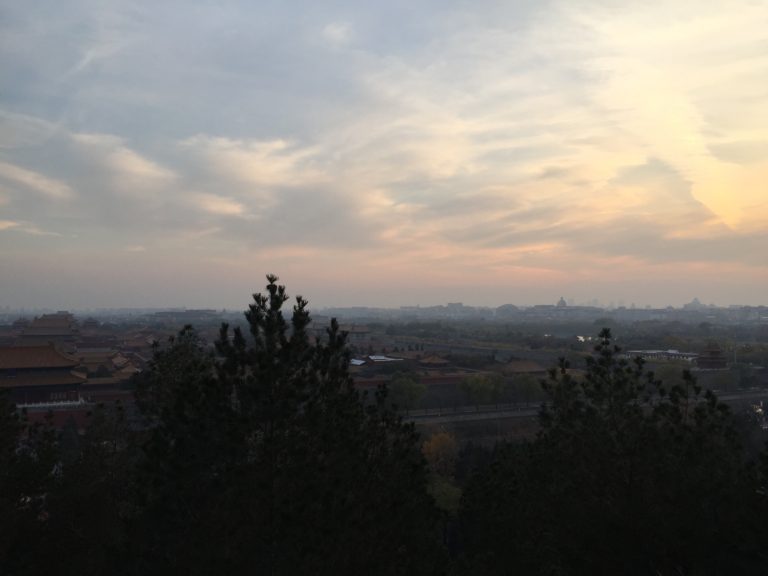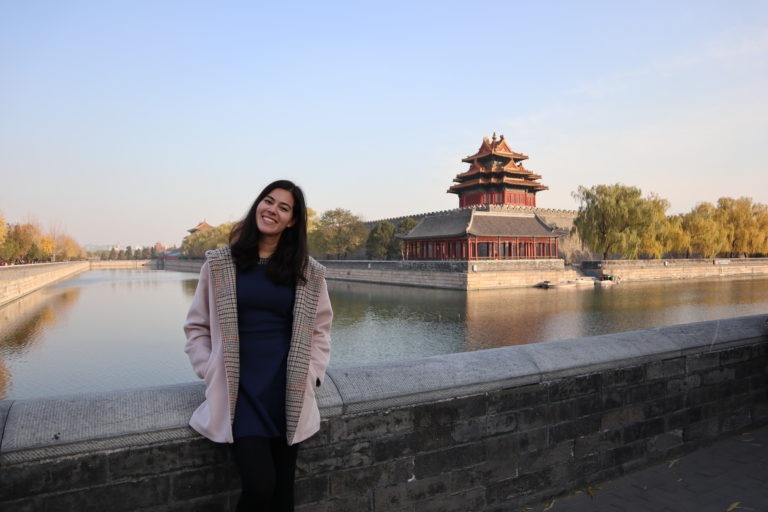What better place to witness the magnificent sight of Beijing’s Forbidden City 故宫 than from a bird’s perspective. The beautiful viewpoint in Jingshan Park offers a fantastic view onto the heart of Beijing’s city center. Surrounded by countless buildings of the mega metropole, the 360-degree view is definitely worth a visit on a less crowded weekday morning.
While living in Beijing, I find it hard to wrap my head around the sheer amount of people that live in the same city and commute to work every day. The city is divided in smaller quarters and every 地区seems to have its own unique flair and atmosphere to discover. Therefore, in November last year, I took the chance and hiked the short trail up to the top of Jingshan park.

With the Forbidden City and Tian’an’men square in immediate vicinity, an afternoon stroll is highly recommended for visitors. The spectacular view of the city北京 (bei3jing1)makes a great 背景(bei4jing3) background…In fact, as a 21st century visitor, chances are high that your top priorities include capturing this precious moment in a photograph.
Let’s find out how to proceed to your dream shot by asking the most professional-looking person around you to take a picture of you and 北京.
(你):你好,请问可以帮我拍张照片吗?
(nǐ ):nǐ hǎo ,qǐng wèn kě yǐ bāng wǒ pāi zhāng zhào piàn ma ?
(You): Hello, could you please help me take a picture?
(看起来很懂摄影的人):恩,可以。【咔嚓,咔嚓】
(kàn qǐ lái hěn dǒng shè yǐng de rén ):ēn ,kě yǐ 。【kā chā ,kā chā 】
(Professional-looking person ) : Ok, sure. [click. click.]
:你看一下,觉得照片怎么样。
nǐ kàn yī xià ,jué de zhào piàn zěn me yàng 。
Check to see whether picture turned out well.
:哇,真好看!谢谢。
wa ,zhēn hǎo kàn !xiè xiè 。
Wow, it looks great! Thanks.
:不客气。
bú kè qì 。
You’re welcome.
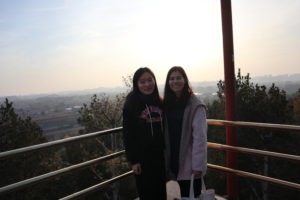
Language progress update
As promised in my l(o)st blog post, I am sharing my 10-week language progress with you today. While this post is posted slightly later than scheduled, I have documented my progress to preserve authenticity. In week 9 at PKU, my Chinese language mid-terms took place. They consisted of a written character exam covering the vocabulary and grammar points of the first nine course book chapters, an elective exam which was listening comprehension in my case and finally, an oral exam covering reading, correct application of grammar as well as free speech abilities.
In the past 9 weeks in China, I adhered to the following DAILY language guidelines in no particular order. While this might not work for every Chinese language student, it certainly has helped me to efficiently develop my language skills.
Before class: 1.5 hours of self-study focused on writing Chinese characters with their pinyin – morning hours are the best for focus work.
During class: Writing down new expressions and example sentences that teachers suggest, keeping vocabulary notebook up to date
After class: Homework, reviewing all new words and repeating old words
After class: Grammar structures that are unclear, noticeable during homework, should be clarified with the teacher the next day and immediately applied in your next chinese conversation
Weekend: Actively seeking contact with Chinese-speaking people, and by that I mean going beyond your basic food-ordering-in-the-canteen-type-of-Chinese: “我要这个然后那个,一两米饭”(I want this then that and some rice) Tip: Join a local activity club in your university such as the Choir or the Chinese form of Kick-boxing
Anytime,anywhere: Practicing your grammar points from class outside of class in a real-life situation
Golden Rule:Mostly avoid conversations bound-to-be in English or ask your classmates to speak in Chinese. Yes, especially in the beginning this is a tough one and requires some discipline but will have a massive impact on your spoken Chinese.
Very short periods of free time such as waiting for the bus: Using a SRC Flashcard system such as ANKI to review new words on your handphone. Perfect for that metro or bus ride, even if it is just two stops. Every minute of repetition counts.
Anytime,anywhere: Immersing yourself in Chinese pop-culture; discover Chinese celebrities and listen to your favourite music genre, in Chinese. Tip: Download QQ music, one of the most popular freemium music services, probably the Spotify of China.
Anytime,anywhere: Add podcasts to fill those empty gaps while getting ready for the day or running on the treadmill with a good old podcast. I currently love listening to the “听故事学中文 – Learning Chinese through stories” and “无业游民“ podcast on the iTunes podcasts app. There are hundreds of Chinese speaking podcasts channels available to check out, such a great time filler for activities that don’t require you to actively think such as running or cleaning etc.

After wholeheartedly following through these guidelines for the first ten weeks of my Chinese language course at PKU, I was happy to report an immense progress from almost zero to being able to voice my opinion on common topics such as introducing my background, talking about hobbies and majors, travels different types of staple food, ordering bubble tea (that one is critical and still causes me to break out in cold sweat when the seemingly endless list of tea options and toppings is presented at 高铁-speed (China’s high-speed rail system)by the professional cashier). However, due to my basic vocabulary, the conversations are currently extremely limited to the words that I am familiar with. This actually helped me to explain myself in the most simple language constructions.
The limited vocabulary leads me to my currently biggest language issue that is called 听力 aka listening comprehension. Say what? Yeah, this is where the frustrations build up like the cabbage 包子 (青菜包子)steamed buns selling out at PKU’s 松林 canteen – let’s just say in no time.
When starting out with Chinese, you probably only understand what you have previously learned. In the exact same pronunciation and order. Which causes a major conversation barrier in the beginning of your Chinese language journey. The frustrating part is that during Chinese class, you seemingly understand most of the teachers content.
However, remember that your teacher has been professionally trained to use simpler vocabulary and sentence constructions to help you ease your way into the language. Hence, outside of class when the harsh reality hits you, that you still barely understand anything at all, we’re back to our good old – 听不懂 (ting1 bu dong3). But don’t worry too much, also this stage will pass.
Just give it some time ~ 慢慢来 (man4 man4 lai2).
~~~
Next week’s blog post will be covering the discovery of Beijing’s Art Zone! Stay tuned until next week back on Curious Seikatsu ~ 下次见 [xià cì jiàn]! In the meantime, don’t forget to have a look at the CS Instagram to the right for getting a preview most recent experiences in Beijing!

